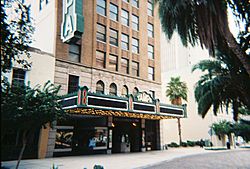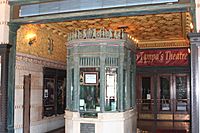Tampa Theatre facts for kids

The outside of the Tampa Theatre around 2006.
|
|
| Full name | Tampa Theatre Building |
|---|---|
| Address | 711 N Franklin St Tampa, FL 33602-4435 |
| Location | Downtown Tampa |
| Owner | City of Tampa |
| Operator | The Arts Council of Hillsborough County |
| Capacity | 1,252 |
| Construction | |
| Broke ground | April 12, 1925 |
| Opened | October 15, 1926 |
| Renovated | 1976-77; 1992; 2009; 2011-12; 2017 |
| Construction cost | $1.2 million ($20 million in 2022 dollars ) |
| Architect | John Eberson |
|
Tampa Theatre
|
|
| Architectural style | Mediterranean Revival |
| NRHP reference No. | 78000945 |
| Added to NRHP | January 3, 1978 |
The Tampa Theatre is a famous historic movie palace and a city landmark in Downtown Tampa, Florida. It opened on October 15, 1926. The architect, John Eberson, designed it as an atmospheric theatre. This means the inside is decorated to make you feel like you're outdoors in a beautiful courtyard at night.
Today, the theatre shows a mix of independent, foreign, and documentary films. It is a non-profit organization, which means it doesn't exist to make money. Instead, it relies on support from members, donations, and ticket sales to stay open. The theatre's unique look has made it a popular setting for movies and music videos.
Contents
A Look Back at the Theatre's History
When the Tampa Theatre opened in the 1920s, it was a very modern building. It was the first commercial building in Tampa to have air conditioning, which was a huge luxury at the time.
A Magical Design
The inside of the theatre is designed to look like a romantic Mediterranean courtyard. It is filled with detailed statues, flowers, and even gargoyles. The most amazing feature is the ceiling, which is painted to look like a dark night sky. Tiny lights sparkle like stars, making moviegoers feel like they are watching a film under the open sky.
How the Community Saved the Theatre
By the 1960s and 1970s, many grand movie palaces like the Tampa Theatre were being torn down. The land they were built on was often worth more than the theatre itself. In 1973, the Tampa Theatre was also in danger of being demolished.
However, the people of Tampa loved their theatre and came together to save it. They formed committees and got city leaders involved. The City of Tampa agreed to take over the theatre's leases to protect it. The Arts Council of Hillsborough County began managing the theatre, showing films and hosting concerts. When it reopened in 1978, the Tampa Theatre became a great example for other cities on how to save a historic theatre.
Since it was saved, the theatre has welcomed over five million visitors. This includes more than a million students who have visited for field trips and summer camps. In 1978, it was added to the National Register of Historic Places, a list of important historic sites in the United States.
Keeping the Theatre Grand
Over the years, the Tampa Theatre has gone through many projects to restore its beauty and upgrade its equipment.
Restorations and Upgrades
In 2004, the theatre celebrated the completion of a new marquee. The marquee is the large sign with the theatre's name on it that hangs over the entrance.
The theatre is also home to the Mighty Wurlitzer Theatre Organ. This special organ was originally used to play music for silent films. Today, volunteer organists play it before nightly movies, keeping a fun tradition alive.
In 2013, the theatre upgraded to digital picture and sound. This cost $150,000 but allowed it to show modern movies. It still keeps its old projectors to show classic films that are only available on movie reels.
The 2017 Renovation
In late 2017, the theatre closed for six weeks for a $6 million renovation. This was a major project to update the building and restore its original 1926 look.
- New Seating: The old seats were replaced with new, more comfortable ones designed to look just like the originals. This reduced the number of seats from 1,446 to 1,238 to give everyone more legroom.
- Original Colors: The lobby's paint and plaster were restored to their original colors. Four large tapestries (woven wall hangings) were recreated to replace the faded originals from 1926.
- Modern Updates: The electrical systems were updated, and a new, larger concession stand was added.
Famous Performers on Stage
The Tampa Theatre is not just for movies. It has also been a popular concert hall for many famous musicians and comedians. Over the decades, the stage has been graced by legendary artists like Ray Charles, B.B. King, and The Police. More recent performers include John Legend, "Weird Al" Yankovic, and Postmodern Jukebox. Hosting these events helps the theatre continue to be a center for arts and entertainment in Tampa.
Gallery







